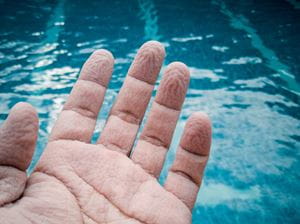It’s an age-old question: Why do our fingers and toes look like raisins after a long soak in the tub or a swim in the pool? Conventional wisdom (also known as “old wives’ tales”) assumed the wrinkles were caused quite by accident, simply through water soaking into the top layer of skin and making it swell.
What really causes “pruning” in the bath?
We learned in the 1930s that our bodies caused the wrinkling on purpose, through the same autonomic nervous system that controls things like heart rate, breathing and sweating. While it’s possible that the water soaks into the outer layer of the skin, research over the last several years seems to point in a different direction: When our fingers and toes are in contact with water for an extended time, the tiny blood vessels under the skin shrink, drawing the skin above them inward.
But why?
We know by now that our bodies weren’t designed by accident—pretty much every strange feature or funny quirk has a purpose. In 2013, scientists finally figured out the purpose of raisin toes. Think of the treads on a car’s tires. When it rains, these treads channel water away from the tires, allowing them to get a better grip on the road. It’s the same with our wet fingers and toes. Research shows that the wrinkles on our fingers offer a definite advantage when we try to pick up wet objects. And, though it hasn’t yet been tested, it’s easy to picture wrinkly toes offering better traction on the wet ground.
A bit of trivia
Want more fun facts about pruny skin? Check these out:
- The only animals found (so far) to get pruny skin in water are macaques, a group of 23 species of monkeys in Asia.
- Scientists compared the wrinkle pattern in pruny fingers and found it to be exactly the opposite of stream beds—which makes sense because while streams channel water together into rivers, the wrinkles force water away from the finger tips.
- It takes about five minutes for wrinkles to form in fresh water, like bath water, but it can take hours for the same effect in saltwater.




